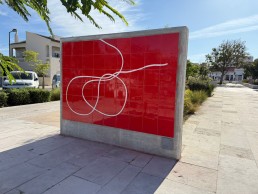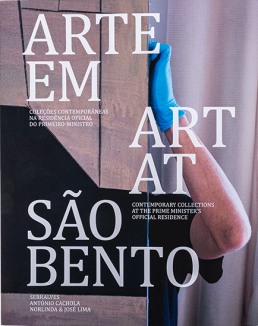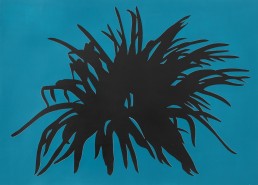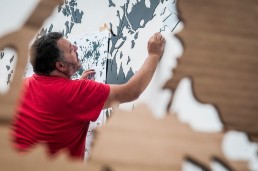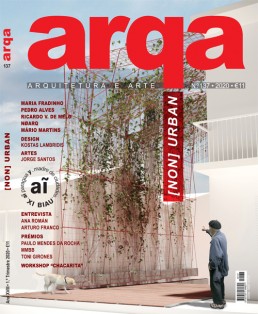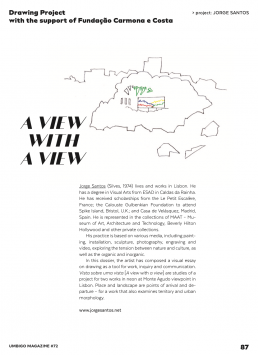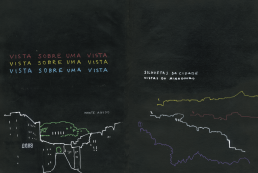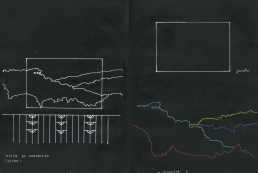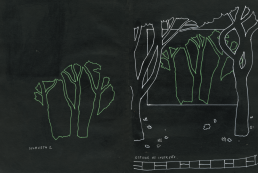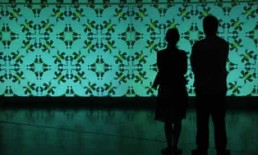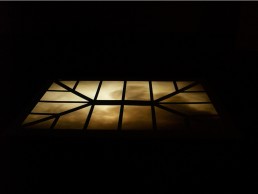Water Hose Panel installed at Largo da República, in Silves

The Jardim do Largo da República in Silves has incorporated into its public space the tile panel Mangueira, a work by Jorge Santos. The piece was acquired by the Municipality of Silves and installed in this garden due to its strategic location next to three schools, allowing students and the community to have direct contact with the artwork.
The panel was produced by Arfai Ceramics Portugal, in Alcobaça, the company responsible for the technical execution in tile, ensuring the piece’s fidelity and quality. Its installation in Silves is part of a broader project that foresees the presence of different art points in the garden, creating a cultural space open to all.
To facilitate access to additional information about the artwork and the artist’s career, a QR Code will be placed in the coming days on the plaque next to the panel, linking to jorgesantos.eu.
This project was made possible thanks to the commitment of the Municipality of Silves and the collaboration of Arfai Ceramics Portugal, to whom thanks are extended for their contribution to incorporating Mangueira into the city’s public space.
Family Album – Works from the Carmona e Costa Foundation Collection
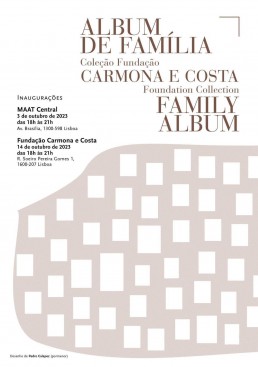
Curators: João Pinharanda and Manuel da Costa Cabral
The exhibition Family Album brings together works from the Carmona e Costa Foundation Collection, Portugal’s largest private collection, which will be presented to the public and critics for the first time.
Maria da Graça Carmona e Costa, currently the most important private patron in the country, has amassed her collection over the last 50 years, but it has never been systematically displayed. Made up of solid authorial sections that cover the decades of activity of the two institutions she created (the Giefarte gallery and the Carmona e Costa Foundation itself), Family Album – Works from the Carmona e Costa Foundation’s Collection reflects not only her personal taste, but also a significant part of the history of Portuguese art in recent decades, explaining the way in which Maria da Graça Carmona e Costa intervened in it by promoting exhibitions or acquisitions. Her initiatives surround, nourish and largely explain the collection, with a permanent and continuous fusion between the collection and the foundation’s activities and between these and the life and tastes of her mentor.
The collection is presented at MAAT (Central building) and, in two instalments, at the headquarters of the Carmona e Costa Foundation. There are therefore three moments to consider: none exhausts or summarises the collection and none fully covers the diversity of the works and names that make it up.
Arte em São Bento 2023 - Coleção Manuel de Brito na Residência Oficial do Primeiro-Ministro
Sorry, this entry is only available in PT.
Jorge Santos Arvoredos e Canaviais I Curadoria de João Silvério
Sorry, this entry is only available in PT.
Guardian - Artist of the week 100: Jorge Santos
in The Guardian: https://www.theguardian.com/artanddesign/2010/aug/11/artist-of-week-jorge-santos
The Portuguese artist’s major subject is memory – beauty is elusive in his quietly minimalist work.
Jorge Santos has a knack for turning the world outside-in. His photography, sculpture, films and drawing call up memories, filling interior space with ghostly doubles of buildings and nature. Brushing up against a gallery wall, you might discover the gentle protrusion of a wrought-iron fence, realised as a white stucco relief, or look down to find autumn leaves reflected in a pool of black acrylic on the floor. Beauty always seems to be on the move – be it a white cloud of smoke that coils and twists, illuminated by a film projector in a dark room, or the twirling, kaleidoscopic flowers that appear in one of his recent video installations.
Born in 1974, the Lisbon-based artist has shown widely in Spain and his native Portugal, and is now having his first UK exhibition at Bristol’s Spike Island. While Santos’s work typically looks cool in pared-down black and white, his quiet minimalism has Romantic and psychological concerns. In early works like Árvore (tree) and Sombra (shadow), nature turns noir: fleeting shadows of trees are mapped in a vast grid of photographs. His 2005 series, of artificial black Perspex puddles etched with leaves, titled Tragaluz (“skylight” in Castilian), seems to invert windows and mirrors, inside and out, heaven and earth, dark and light.
Santos’s major subject is memory. He explores its Proustian and Uncanny surprises in reproductions of what he finds in the landscape around the galleries he works in. From a distance his work Blind Gate, included in his current show, seems no more than two large sheets of white paper, fluttering against the wall they’re pinned to. Close up, the delicate embossed pattern of riverside fencing comes into focus. Step too far back, however, and the vision vanishes.
Why we like him: For the eerie Gothic beauty of his 2009 video Branches That Blow. Seen in silhouette against the moon, two branches extend their fingers towards one another like uncertain lovers, beneath a breathy, whispering soundtrack.
My Funny Valentine: Santos’s Fragments of Love Songs, drawings that look like gravestones or memorial tablets, seem engraved with lyrics from love songs. His own favourites, he says, are Chet Baker‘s, “because they’re all about loss and rediscovery”.
First love: While Santos cites Rachel Whiteread and Félix González-Torres as particular inspirations, the first artist to make an impression on him was Modigliani. He recalls being wowed by the long necks and disturbing lack of eyes of the Italian painter’s subjects when he first saw prints of his work in a doctor’s waiting room at the age of six.
Where can I see him?: Jorge Santos’s solo exhibition, the world appeared to her reflected by pure inwardness, is at Spike Island, Bristol until 26 September.
JORGE SANTOS: un lisbonese racconta la città.
Per capire meglio le dinamiche sociali, culturali ed artistiche della città, abbiamo incontrato Jorge Santos, artista lisbonese attento a ciò che gli accade attorno e fiero della sua appartenenza alla comunità artistica cittadina.
«Lisbona è cambiata molto negli ultimi anni. Ciò è dovuto ad una scoperta tardiva della città dalle grandi rotte del turismo internazionale. Prima si poteva vivere e lavorare abbastanza economicamente… ora no: la gentrification e la vendita di ogni angolo disponibile, la trasformazione di interi palazzi in alberghi, lo svuotamento del centro storico da parte di airbnb… Per fortuna l’arte contemporanea sta facendo un altro percorso: la città è di moda, e quindi dà più visibilità alla sua arte ed ai suoi artisti, che erano stati dimenticati, un po’ come la città in sé, o rimasti ostaggio di istituzioni che promuovevano solo alcuni di loro. Fra l’altro, questo cambiamento avviene in un’epoca in cui anche il paradigma dell’arte contemporanea sta cambiando: internet permette agli artisti di essere più indipendenti e di mettere in discussione il ruolo delle gallerie e del mercato. Sono sorti nuovi spazi ed antiche gallerie indipendenti sono nuovamente visibili, e nuove fiere d’arte attraggono nuovi collezionisti. Lisbona è una bella e calda città. Ha un’identità unica che nasce dalla fusione di culture di paesi come Angola, Capo Verde, Mozambico e Brasile. La miscela fra queste culture e la cultura portoghese fa della città un luogo unico e diverso da qualsiasi altra capitale d’Europa e del mondo. Nonostante la sua periferia. Mentre il mondo tende verso una certa omogeneità, penso che la città, in un certo modo, viva un momento singolare nella sua storia. È un rifugio per molte nazionalità che cercano un luogo sicuro in cui vivere e crescere. Io vedo il futuro con speranza ma anche con un po’ di apprensione. Penso che la città possa facilmente essere vittima di tutti i rischi inerenti alla globalizzazione, come purtroppo accade oggi in ogni luogo nel mondo, in cui il capitale è il valore dominante. Le istituzioni pubbliche hanno una attitudine piuttosto conservatrice nei confronti dell’arte e degli artisti e poche risorse per il sostegno del sistema artistico a lungo termine. Dopo aver avuto un governo che ha fatto sparire il Ministero della Cultura, ora abbiamo un’atmosfera più favorevole, ma la verità è che il bilancio statale per la cultura è ancora molto insufficiente, così come lo è il supporto specifico per le arti, che è quasi nullo. Gli artisti contemporanei portoghesi hanno grandi difficoltà a riuscire a sopravvivere solo del loro lavoro artistico in un paese ancora molto conservatore e dove non esiste un mercato forte per l’arte contemporanea e dove l’unica via d’uscita per molti è l’internazionalizzazione. Amo vivere e lavorare a Lisbona. La città ha una grande influenza sul mio lavoro. Vivo e lavoro nel centro storico che si è deteriorato grazie all’ondata di decaratterizzazione del turismo di massa, in una città ancora periferica, e quindi un luogo in cui è difficile per un artista vivere dal suo lavoro con la scala dell’economia nazionale. Nonostante questo, vedo la città ancora come uno spazio abbastanza libero ed informale, dove c’è molto da fare soprattutto nell’educazione e nella costruzione di una realtà per un mercato dell’arte contemporanea». Lisbona ci conferma di essere una città in movimento, in cui i linguaggi artistici e la creatività si aprono al futuro come essa si apre sull’oceano.
In ESPOARTE
Exposições de Jorge Santos em Guimarães e no Porto
A natureza e o espaço doméstico vistos pelo artista que esteve em Inglaterra com uma bolsa Gulbenkian.
Em The House Translated into the Landscape, o artista visual Jorge Santos propõe uma abordagem da representação da natureza no espaço doméstico. A exposição que ocupa as galerias 2 e 3 do Centro para os Assuntos da Arte e Arquitectura (CAAA), em Guimarães, explora a relação entre a arquitectura e a natureza e também a noção de fronteira do espaço humano para com o mundo natural.
Por isso, a peça que acolhe os visitantes, Groto, é uma representação de um portão em negativo, feita em vinil sobre uma parede. “Há uma representação do que é natural, misturando-se com aquilo que é construído, mas sempre descontextualizado, num interior”, explica o artista plástico, que tem a sua carreira baseada em Lisboa.
A outra obra desta exposição em Guimarães é Spring Cage, uma vídeo-instalação, de oito minutos, que pela primeira vez é exposta em Portugal, depois de no ano passado ter sido estreada em Bristol, no Reino Unido. O vídeo explora o conceito de papel de parede digital, que vai sofrendo ligeiras mutações ao longo da projecção. Este trabalho foi criado em 2010, fruto de uma bolsa da Fundação Calouste Gulbenkian, que permitiu ao artista viver em Inglaterra. Ali teve contacto privilegiado com o movimento decorativista vitoriano que influencia fortemente as suas criações. A exposição de Jorge Santos foi inaugurada simultaneamente com a de Daniel Blaufuks e estará patente no Centro para os Assuntos da Arte e Arquitectura. também até 26 de Maio. A uma curta viagem de distância, na galeria Presença, no Porto, o mesmo artista tem outra exposição de trabalhos seus, que pode ser visitada até 13 de Abril. Ali, podem ser vistos, Flower Ornament – uma série de desenhos dourados, impressos através do “ferimento” do papel – e Blacklight Dahlias, um trabalho de fotografia, feito a partir de uma residência artística em França. S.S.
In Jornal Público, https://www.publico.pt/2013/03/26/jornal/exposicoes-de-jorge-santos-em-guimaraes-e-no-porto-26281285
